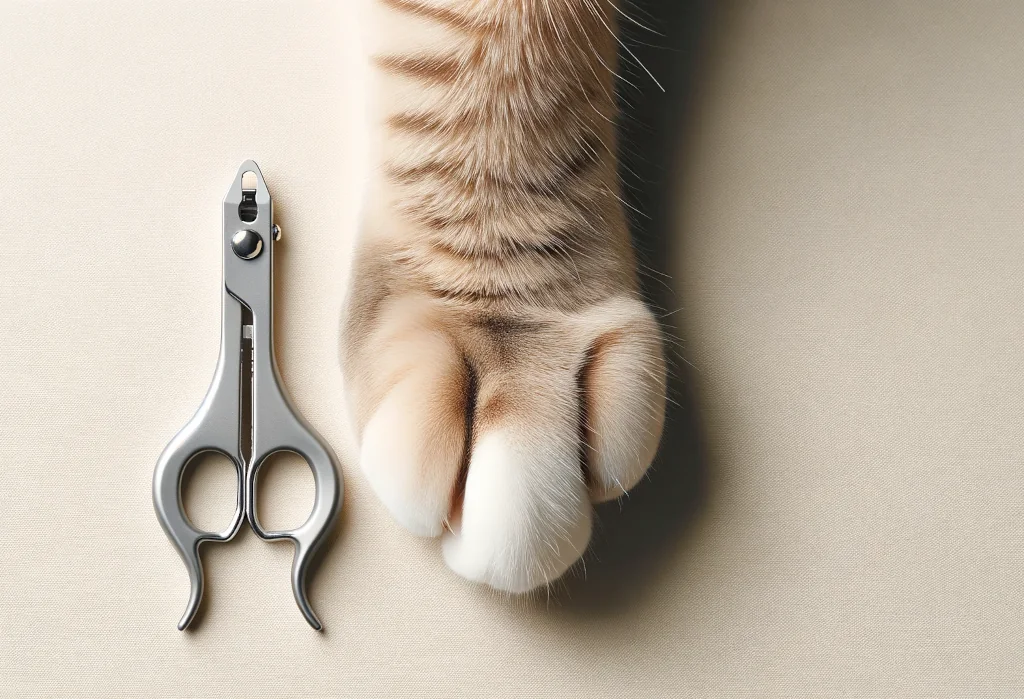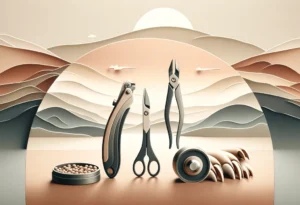Disclosure: We may earn a commission from helpful, relevant links in our content. No cost to you. See our privacy policy.
Anyone who’s attempted to trim a cat’s nails knows it’s akin to defusing a tiny, fluffy bomb—with purring. Slightest misstep and you’re up against the full fury of those adorable paws.
Through this guide, you’ll learn the whisker-licking good secrets to a peaceful trim, making the experience a catwalk in the park for both you and your feline friend.
Key takeaways:
- Trim your cat’s nails every 1-2 weeks to protect furniture, prevent painful overgrowth, and make playtime scratch-free.
- Gradually acclimate your cat to paw handling with treats and praise, and use proper tools—a scissor-type trimmer, guillotine-type trimmer, or grinder.
- Cut only the translucent part of the nail, avoid the quick, and have styptic powder on hand for accidental nicks.
Why Trim Your Cat’s Claws?
Regular claw trimming is a must, especially for indoor felines. First off, it’s a game-changer for your beloved couch and curtains—keeping those claws neat means saying goodbye to unintentional scratch marks on furniture. But it’s not just about your home decor. Trimmed claws help prevent painful nail overgrowth and the potential for ingrown claws, both of which can lead to infections and a hefty vet bill.
Beyond furniture and health concerns, short claws mean you and your family can enjoy playtime with kitty without the worry of scratches. Not to mention, your cat’s social life—groomers, vets, and fellow furry friends will all appreciate their manicured paws. So, in the grand scheme of things, a little clip can lead to a smoother, happier coexistence.
When Should You Trim Your Cat’s Nails?
Keep an eye out for certain tell-tale signs—it might be time for a trim when your cat starts leaving scratch marks, gets her claws stuck in the carpet, or her “clickety-clack” becomes the soundtrack of your home. Most cats need a nail trimming session every 1 to 2 weeks, but remember, every kitty’s different; some may need it more often, particularly if they’re not wearing their nails down naturally with outdoor activity.
The best time to trim? When your cat is in a chill mood—post nap, after a meal, or following a gentle play session can be ideal moments. Nail trimming shouldn’t be a wrestling match, so pick a time when both of you are relaxed.
How Do You Prepare Your Cat for Nail Trimming?
Creating a calm atmosphere is step one. Choose a cozy spot and wait for a time when your cat is mellow—no distractions. Now, patience is key. Gradually get your cat used to having their paws handled; start by touching and gently pressing their paws during cuddle times. Treats and calming words go a long way in building positive associations.
When it comes to the moment of truth, hold your cat in your lap or place them on a comfortable surface, and use sharp, clean clippers designed for cats. Here’s a golden nugget of advice: lightly press the paw to expose the claw, and focus on cutting only the translucent part of the nail—avoiding the pink ‘quick’ which is sensitive and may bleed if cut.
Remember, nail trimming is like any relationship—it grows stronger with trust and understanding. So, keep sessions short, sweet, and always end on a positive note with their favorite treat or a loving pat. Your cat’s comfort is the ultimate win here, so take things slow and keep it positive. This way, you’ll both be pros in no time.
What Tools Do You Need?
Before you dive in, let’s chat about the toolkit you’ll need. Just like a chef needs their knives, you’ll need the right nail trimmers to keep your cat’s paws healthy.
- Scissor-type Trimmers: Great for precision, these look like scissors but have a notch to cradle the nail. If you’re all thumbs, these can be a bit tricky, so it might not be the best pick for beginners.
- Guillotine-type Trimmers: Pop the nail in, squeeze, and it’s snip-snap done! This type is super easy to use, making it a top pick for newbies.
- Grinder Tools: Think of these as the nail files of the cat world. They’re good for smoothing out edges but require a patient cat and human.
No matter which trimmer tickles your fancy, having styptic powder or similar aids on hand is a must. Accidents happen – even Picasso had his off days. If you nick the quick (the pink part of the nail where blood vessels are), a dab of this powder will help stop the bleeding.
Remember, it’s not just the tools, but also the approach that counts. A cool head and a calm kitty will make for a fuss-free trim.
How Do You Safely Trim Your Cat’s Claws?
Now, let’s walk through the process step by step. No rush; we’re going for quality, not speed records.
- Create a Zen Zone: Pick a quiet space. A relaxed cat is easier to work with.
- Paw Handling Practice: Before the main event, get your kitty used to having their paws touched. Treats can be a good bribe—er, incentive.
- Spot the Quick: It’s the pinkish area inside the nail. Avoid it like the last slice of pie at Thanksgiving – cutting it means pain and bleeding for your furball.
- The Right Angle: Hold the trimmer perpendicular to the nail to prevent splitting.
- Just the Tip: No need to go deep; a small cut off the sharp end is all you need.
- One Paw at a Time: Start with one nail. If your cat stays calm, praise them, give a treat, and gently press on to the next.
- Dealing with the Wiggles: If your cat gets grumpy or fidgety, take a break. Forced grooming sessions help no one.
Did you know that most folks miss the thumb claw? It’s higher up on the paw, and it’s a unique tip worth noting, as it tends to get snagged on things.
What If Your Cat Completely Objects?
Sometimes, you meet a cat that just says no. If your sweet furball turns into a hissing ball of claws, it’s time for some new tactics.
- Distraction with Toys or Food: Might work for the cat who can’t resist a good treat or playtime.
- Desensitization: Gradual exposure can work wonders. Regularly handle their paws without trimming, building up to actual clipping.
- Professional Groomers: They’ve seen it all and have the skills to match. No shame in seeking help.
- Vet Assistance: For the most challenging cases, or if your cat needs sedation. Your vet’s got your back, and your cat’s paws.
And for a non-trimming solution, consider soft paw caps. They’re like little booties for your cat’s nails—both cute and practical.
Remember, patience is everything. Each cat’s comfort level is as unique as their personality, and respecting that is the key to stress-free trimmings. If you’re in doubt, or if things don’t seem to be improving, a vet or a professional groomer should be your go-to. Your sanity—and your cat’s well-being—is worth it.
Nail trimming shouldn’t be a cat-and-mouse game. With the right tools, approach, and a little bit of savvy, you’ll have it down to a fine art. Your cat’s paws are in good hands!
Alex, a passionate animal lover, has experience in training and understanding animal behavior. As a proud pet parent to two dogs and three cats, he founded AnimalReport.net to share insights from animal experts and expand his knowledge of the animal kingdom.





